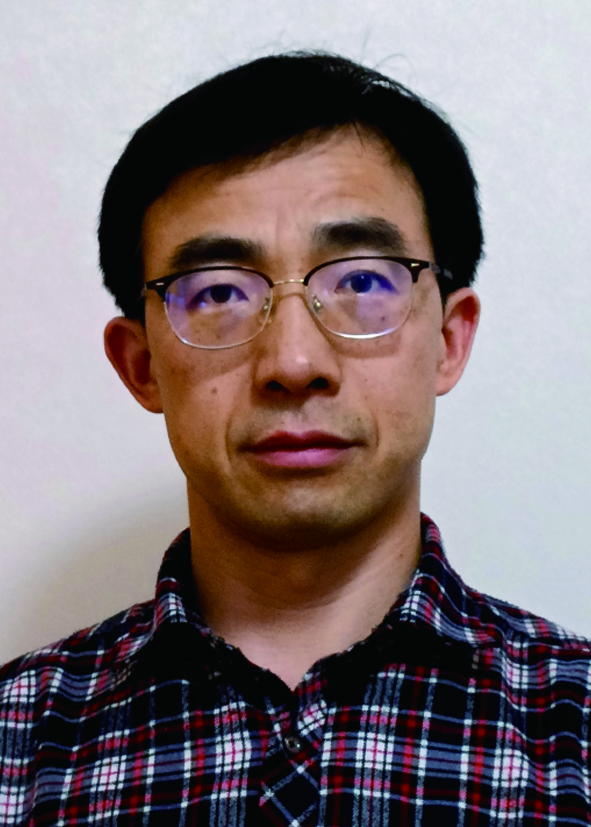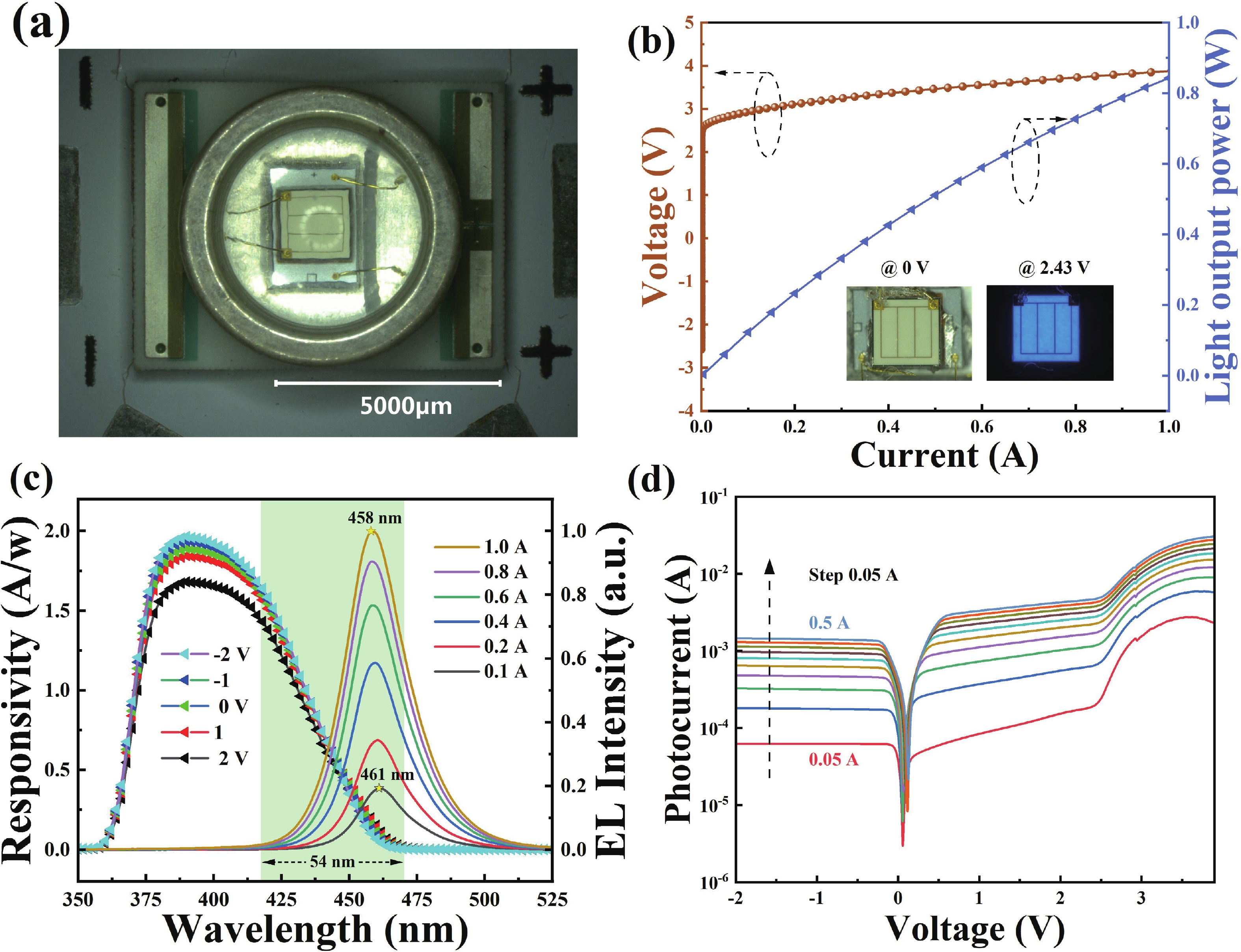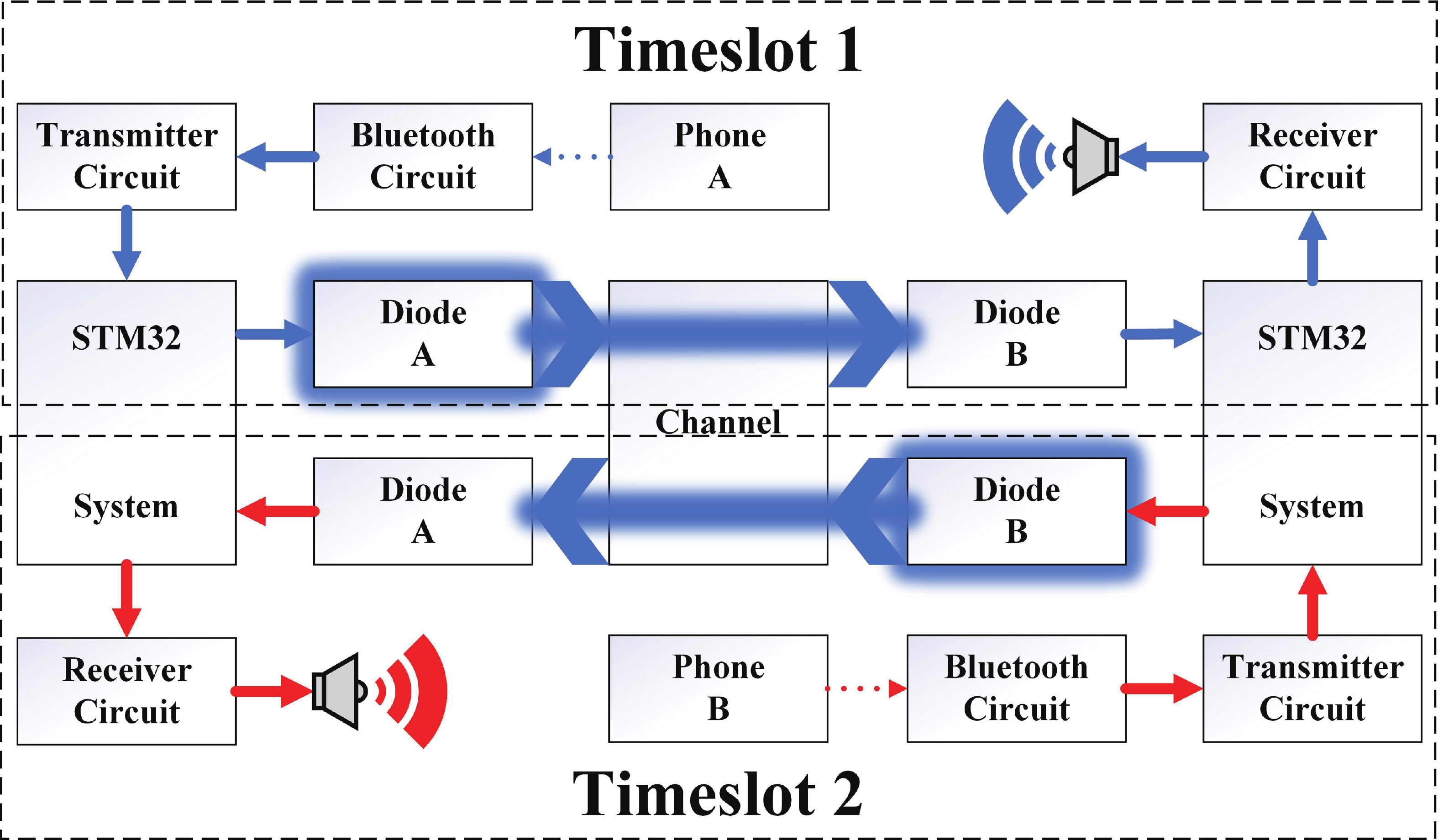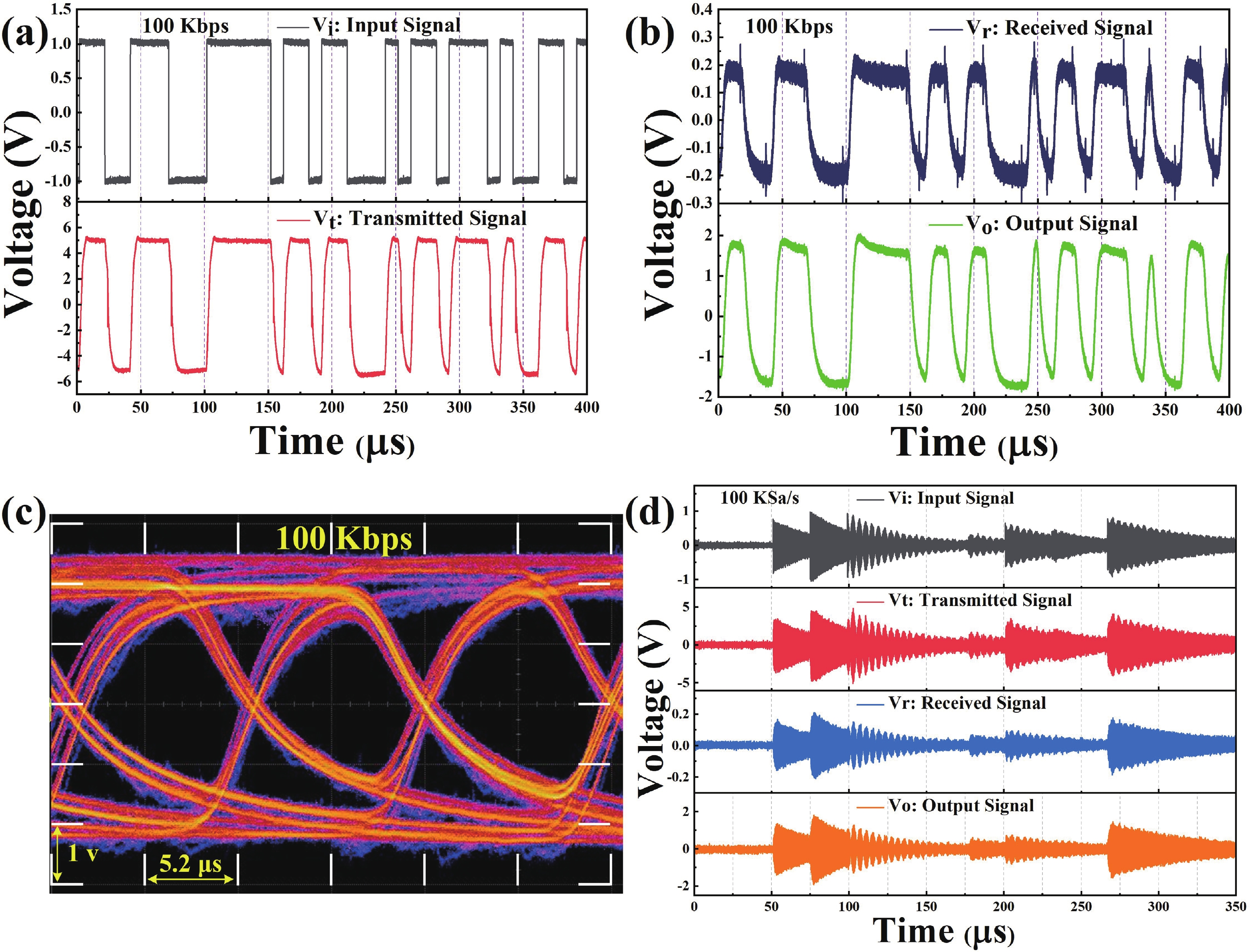| Citation: |
Pengzhan Liu, Linning Wang, Jiayao Zhou, Xinijie Mo, Yingze Liang, Jiahao Gou, Ziqian Qi, Ziping Cao, Yongjin Wang. Mobile blue-light communication over a signal optical path using a time-division multiplexing scheme[J]. Journal of Semiconductors, 2025, 46(3): 032402. doi: 10.1088/1674-4926/24080022
****
P Z Liu, L N Wang, J Y Zhou, X J Mo, Y Z Liang, J H Gou, Z Q Qi, Z P Cao, and Y J Wang, Mobile blue-light communication over a signal optical path using a time-division multiplexing scheme[J]. J. Semicond., 2025, 46(3), 032402 doi: 10.1088/1674-4926/24080022
|
Mobile blue-light communication over a signal optical path using a time-division multiplexing scheme
DOI: 10.1088/1674-4926/24080022
CSTR: 32376.14.1674-4926.24080022
More Information-
Abstract
Multiple quantum well (MQW) Ⅲ-nitride diodes that can simultaneously emit and detect light feature an overlapping region between their electroluminescence and responsivity spectra, which allows them to be simultaneously used as both a transmitter and a receiver in a wireless light communication system. Here, we demonstrate a mobile light communication system using a time-division multiplexing (TDM) scheme to achieve bidirectional data transmission via the same optical channel. Two identical blue MQW diodes are defined by software as a transmitter or a receiver. To address the light alignment issue, an image identification module integrated with a gimbal stabilizer is used to automatically detect the locations of moving targets; thus, underwater audio communication is realized via a mobile blue-light TDM communication mode. This approach not only uses a single link but also integrates mobile nodes in a practical network. -
References
[1] Van Deurzen L, Kim E, Pieczulewski N, et al. Using both faces of polar semiconductor wafers for functional devices. Nature, 2024, 634(8037), 334 doi: 10.1038/s41586-024-08199-x[2] Pimputkar S, Speck J S, DenBaars S P, et al. Prospects for LED lighting. Nat Photonics, 2009, 3(4), 180 doi: 10.1038/nphoton.2009.32[3] Wierer J J, David A, Megens M M. Ⅲ-nitride photonic-crystal light-emitting diodes with high extraction efficiency. Nat Photonics, 2009, 3(3), 163 doi: 10.1038/nphoton.2009.21[4] Ren A B, Wang H, Zhang W, et al. Emerging light-emitting diodes for next-generation data communications. Nat Electron, 2021, 4(8), 559 doi: 10.1038/s41928-021-00624-7[5] Oh N, Kim B H, Cho S Y, et al. Double-heterojunction nanorod light-responsive LEDs for display applications. Science, 2017, 355(6325), 616 doi: 10.1126/science.aal2038[6] Xu Z J, Ren J W, Wang C, et al. Equivalent analysis model of a GaN LED used as a receiver. Appl Opt, 2024, 63(12), 3108 doi: 10.1364/AO.516900[7] Stepniak G, Kowalczyk M, Maksymiuk L, et al. Transmission beyond 100 Mbit/s using LED both as a transmitter and receiver. IEEE Photonics Technol Lett, 2015, 27(19), 2067 doi: 10.1109/LPT.2015.2451006[8] Kumar N, Nguyen T T, Lee J, et al. Van der waals semiconductor based omnidirectional bifacial transparent photovoltaic for visual-speech photocommunication. Adv Sci, 2024, 11(7), 2306408 doi: 10.1002/advs.202306408[9] Kowalczyk M, Siuzdak J. Photo-reception properties of common LEDs. Opto Electron Rev, 2017, 25(3), 222 doi: 10.1016/j.opelre.2017.06.009[10] Fandiño J S, Muñoz P, Doménech D, et al. A monolithic integrated photonic microwave filter. Nat Photonics, 2017, 11(2), 124 doi: 10.1038/nphoton.2016.233[11] Stojanović V, Ram R J, Popović M, et al. Monolithic silicon-photonic platforms in state-of-the-art CMOS SOI processes. Opt Express, 2018, 26(10), 13106 doi: 10.1364/OE.26.013106[12] Wei W Q, He A, Yang B, et al. Monolithic integration of embedded Ⅲ-Ⅴ lasers on SOI. Light Sci Appl, 2023, 12(1), 84 doi: 10.1038/s41377-023-01128-z[13] Remis A, Monge-Bartolome L, Paparella M, et al. Unlocking the monolithic integration scenario: Optical coupling between GaSb diode lasers epitaxially grown on patterned Si substrates and passive SiN waveguides. Light Sci Appl, 2023, 12(1), 150 doi: 10.1038/s41377-023-01185-4[14] Zheng Z Y, Zhang L, Song W J, et al. Gallium nitride-based complementary logic integrated circuits. Nat Electron, 2021, 4(8), 595 doi: 10.1038/s41928-021-00611-y[15] Wang Y J, Wang X, Zhu B C, et al. Full-duplex light communication with a monolithic multicomponent system. Light Sci Appl, 2018, 7(1), 83 doi: 10.1038/s41377-018-0083-0[16] Xie M Y, Hu F C, Ma C C, et al. 580-nm-thick vertical-structure light-emitting diode for visible light communication. Appl Phys Lett, 2022, 120(18), 181109 doi: 10.1063/5.0088846[17] Zhang H, Yan J B, Ye Z Q, et al. Monolithic GaN optoelectronic system on a Si substrate. Appl Phys Lett, 2022, 121(18), 181103 doi: 10.1063/5.0125324[18] Dang S P, Amin O, Shihada B, et al. What should 6G be? Nat Electron, 2020, 3(1), 20[19] Pathak P H, Feng X T, Hu P F, et al. Visible light communication, networking, and sensing: A survey, potential and challenges. IEEE Commun Surv Tutor, 2015, 17(4), 2047 doi: 10.1109/COMST.2015.2476474[20] Zhang J L, Wang S J, Ma Z Q, et al. Long-term and real-time high-speed underwater wireless optical communications in deep sea. IEEE Commun Mag, 2024, 62(3), 96 doi: 10.1109/MCOM.001.2300461[21] Xu X Y, Fu Y X, Shi Z R, et al. Stable and self-healing perovskite for high-speed underwater optical wireless communication. J Mater Chem C, 2024, 12(11), 3907 doi: 10.1039/D3TC04809H[22] Zhao C, Hua N, Song J W, et al. Channel-aware low Earth orbit satellite cluster networking for space-to-Earth laser communication: Reliability and bandwidth advantages. Opt Express, 2024, 32(3), 3356 doi: 10.1364/OE.511256[23] Wang G H, Yang F, Song J, et al. Free space optical communication for inter-satellite link: Architecture, potentials and trends. IEEE Commun Mag, 2024, 62(3), 110 doi: 10.1109/MCOM.002.2300024[24] Hoppe D, Biswas A, Srinivasan M, et al. Deep space optical communications technology demonstration. Free-Space Laser Communication and Atmospheric Propagation XXX, 2018, 12877 doi: 10.1117/12.2296426[25] Tian R Y, Wang T, Shen X Y, et al. 108 m underwater wireless optical communication using a 490 nm blue VECSEL and an AOM. Sensors, 2024, 24(8), 2609. doi: 10.3390/s24082609[26] Chow C W, Shiu R J, Liu Y C, et al. Non-flickering 100 m RGB visible light communication transmission based on a CMOS image sensor. Opt Express, 2018, 26(6), 7079 doi: 10.1364/OE.26.007079[27] Yang X Q, Zhang Y F, Hua Y, et al. 50-M/300-Mbps underwater wireless optical communication using incoherent light source. J Light Technol, 2023, 41(22), 6939 doi: 10.1109/JLT.2023.3295343[28] Zhang K K, Sun C M, Shi W, et al. Turbidity−tolerant underwater wireless optical communications using dense blue-green wavelength division multiplexing. Opt Express, 2024, 32(12), 20762 doi: 10.1364/OE.521575[29] Liu P Z, Qi Z Q, Fu J W, et al. Unification of irreversibility and energy diagram theory. ACS Omega, 2023, 8(22), 20004 doi: 10.1021/acsomega.3c02189 -
Supplements
 Mobile_blue_light_communication_system.mp4
Mobile_blue_light_communication_system.mp4

-
Proportional views





 Pengzhan Liu received the M.S. degree from Nanjing university of posts and telecommunications. Now he is a PhD student at Nanjing university of posts and telecommunications under the supervision of Prof Ziping cao and Yongjin Wang. He is mainly engaged in the research of all light wireless optical communication Network and integrated GaN optoelectronic devices.
Pengzhan Liu received the M.S. degree from Nanjing university of posts and telecommunications. Now he is a PhD student at Nanjing university of posts and telecommunications under the supervision of Prof Ziping cao and Yongjin Wang. He is mainly engaged in the research of all light wireless optical communication Network and integrated GaN optoelectronic devices. Linning Wang received the B.S. degree in communications engineering and the master’s degree in electronics and communication engineering from the Nanjing University of Posts and Telecommunications, Nanjing, China, in 2018 and 2021, respectively. He is currently working toward the Ph.D. degree in communication and information system with the Nanjing University of Posts and Telecommunications. He is mainly engaged in the research of wireless optical communication and its application systems, including embedded developments, communication electronic, and signal processing circuits.
Linning Wang received the B.S. degree in communications engineering and the master’s degree in electronics and communication engineering from the Nanjing University of Posts and Telecommunications, Nanjing, China, in 2018 and 2021, respectively. He is currently working toward the Ph.D. degree in communication and information system with the Nanjing University of Posts and Telecommunications. He is mainly engaged in the research of wireless optical communication and its application systems, including embedded developments, communication electronic, and signal processing circuits. Ziping Cao received the B.S. and M.S. degrees in materials science and engineering from the Kunming University of Science and Technology, Kunming, in 2002, and the Ph.D. degree in materials physics and chemistry from the Chinese Academy of Sciences, Shanghai, in 2005. Since 2012, he has been a Professor with the School of Telecommunication and Information Engineering, Nanjing University of Posts and Telecommunications, Nanjing, China. His research interests include power line carrier communication, wireless sensor networks, environmental energy harvesting, and contactless energy transferring.
Ziping Cao received the B.S. and M.S. degrees in materials science and engineering from the Kunming University of Science and Technology, Kunming, in 2002, and the Ph.D. degree in materials physics and chemistry from the Chinese Academy of Sciences, Shanghai, in 2005. Since 2012, he has been a Professor with the School of Telecommunication and Information Engineering, Nanjing University of Posts and Telecommunications, Nanjing, China. His research interests include power line carrier communication, wireless sensor networks, environmental energy harvesting, and contactless energy transferring. Yongjin Wang received the Ph.D. degree in microelectronics and solid-state electronics from the Shanghai Institute of Microsystem and Information Technology, Chinese Academy of Sciences, Shanghai, China, in 2005. Since 2011, he has been a Professor with the Nanjing University of Posts and Telecommunications, Nanjing, China. He is currently the Chief Investigator of National Innovation Base for Micro−Nano Device and Information System. His research interests include Ⅲ-nitride monolithic photonic circuit for visible light communication and the Internet of Things.
Yongjin Wang received the Ph.D. degree in microelectronics and solid-state electronics from the Shanghai Institute of Microsystem and Information Technology, Chinese Academy of Sciences, Shanghai, China, in 2005. Since 2011, he has been a Professor with the Nanjing University of Posts and Telecommunications, Nanjing, China. He is currently the Chief Investigator of National Innovation Base for Micro−Nano Device and Information System. His research interests include Ⅲ-nitride monolithic photonic circuit for visible light communication and the Internet of Things.
 DownLoad:
DownLoad:























